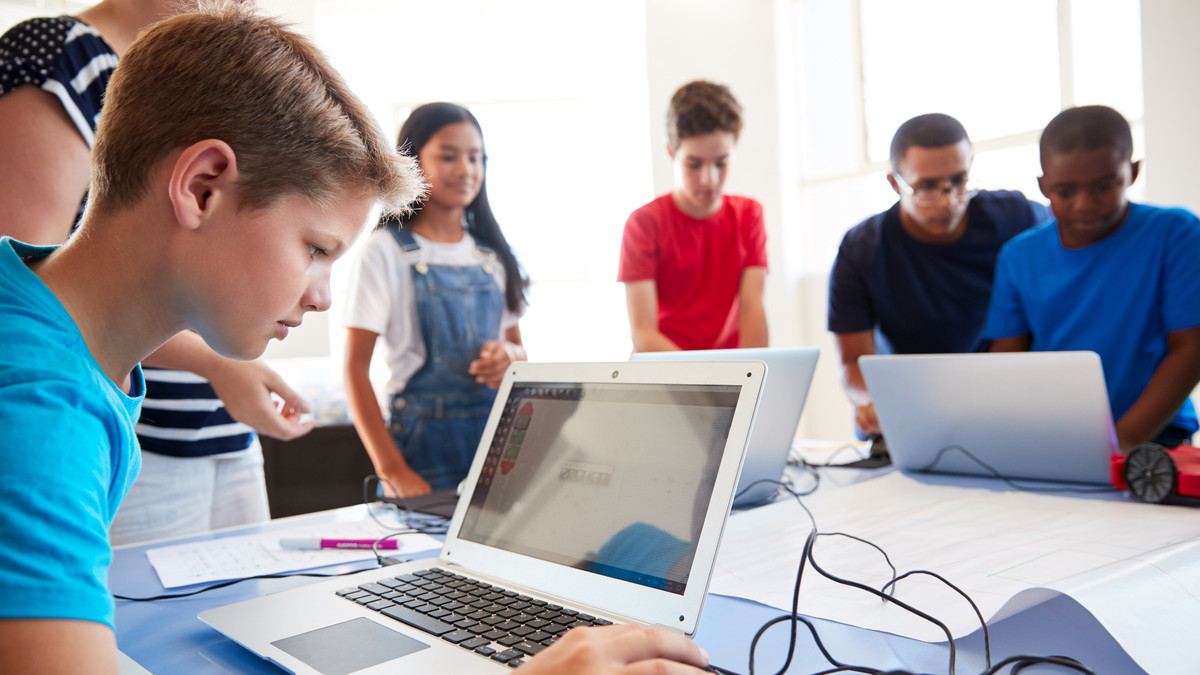The students in Lauren Pritchard’s reading class on Friday morning, Feb. 21, all had laptops on their desks.
The seventh and eighth graders, students at Crabapple Middle School in Roswell, were taking an online assessment after a week of various lessons. Pritchard says they use the laptops for the assessments because it collects data for teachers to dissect and also sends alerts in real time when a student answers a question incorrectly.
The sight is not unusual, but it’s becoming more deliberate. Schools across the country began implementing technology into their lesson plans more than a decade ago, a sign of where things were headed as smartphones became as important as limbs. But as more and more back away from their devices, and take longer breaks from social media, the hum of laptop motors is being replaced with what it overtook: human interaction.
“We swung to one side of the pendulum where everything was device-driven,” said Rako Morrissey, the principal at Crabapple. “Then, we realized the device doesn’t address the whole child development. For the last few years, it’s been about pushing that pendulum back to the middle.
“Students still need to know how to talk to each other.”
The technology, though, won’t go away altogether. It takes away some of the paperwork that has bogged down teachers over the years. And the data collection helps teachers understand their students’ needs while giving students and teachers more time to engage. Most school systems have built digital learning portals that allow students to do homework when they miss school, or even to log in and complete assignments on inclement weather days.
Recent studies speak to technology’s strengths and weaknesses when it comes to young minds. An Education Week blog reported that Common Sense Media, a San Francisco nonprofit that studies the impact of technology and social media on young people, discovered through national polls that more than half the students felt technology and social media were tearing us apart more than they are bringing people together. Some said they sometimes turn off their phones just to get relief, regardless of then finding themselves feeling disconnected.
Morrissey, who has researched engagement in various forms, said for the six years she has been at Crabapple, she and her staff have taken deliberate measures to balance the use of technology with human interaction. Lesson plans include “turn and talk” moments, when students work with each other and their teacher on lessons.
“Engagement is about relevancy, bringing purpose to what we’re doing,” Morrissey said. “Without good engagement practices, the children are not going to learn.”
Some classes at the school don’t use devices at all. In a classroom at the end of one of the school’s hallways, Fulton County Board of Education member Katha Stuart talked to students about her journey in education leadership, among other things. The chat was part of a series done at the school where different people visit the school, motivating students to work by showing what is possible. Past speakers have included college students and working professionals.
“We want them to see themselves in different people,” Morrissey said.
In Karla Ess’ math class that morning, students were split into three groups working math problems using trapezoids. On their desks were paper and calculators. That’s not to say technology doesn’t come into play, Ess said, adding she uses the district’s digital learning software to extend and enhance lessons.
“I create videos in my absence,” she said, adding, “They’re listening to me and taking notes. But there’s a balance. This is where life outside of school is headed, so it will always be a balance. It won’t be 100%.”
In the DeKalb County School District, the Digital Dreamers initiative was implemented for several reasons. Key among them was to make sure all students had access to technology to help better prepare them for life outside school. Monika Davis, the district’s director of virtual learning, said the district developed a digital learning ecosystem with strategies for online learning, adding resources and tools. How it is balanced with personal interaction is a classroom-by-classroom situation, she admits.
“When is it too much?” Davis said about the technology. “That’s a decision a teacher has to make. Some assignments don’t require technology.”
Back in Lauren Pritchard’s Crabapple Middle classroom, while students take the online assessment, several stacks of worksheets sit on a table in the back of the room waiting for when a student selects a wrong answer, refreshers for the earlier lessons. She walks the rows in her classroom, surveying as students complete the assessment.
“You did this really fast,” she tells one student.
“Yes,” he said.
“You want to go back and recheck them?” she asks.
“Uh-huh.”
This article was written by Marlon A. Walker from The Atlanta Journal-Constitution and was legally licensed via the Tribune Content Agency through the NewsCred publisher network. Please direct all licensing questions to legal@newscred.com.
